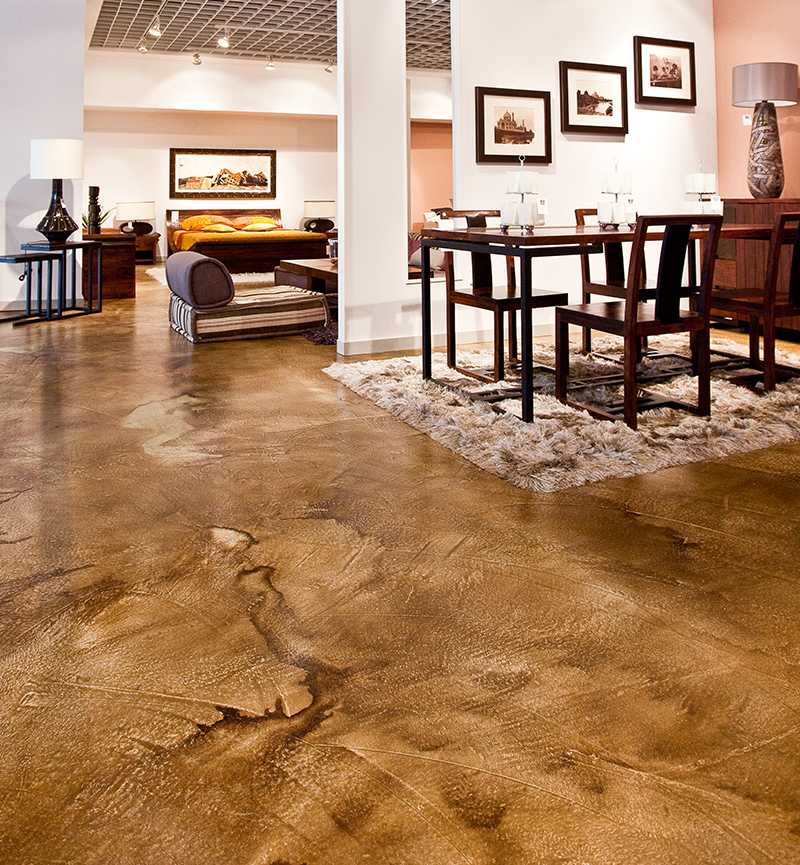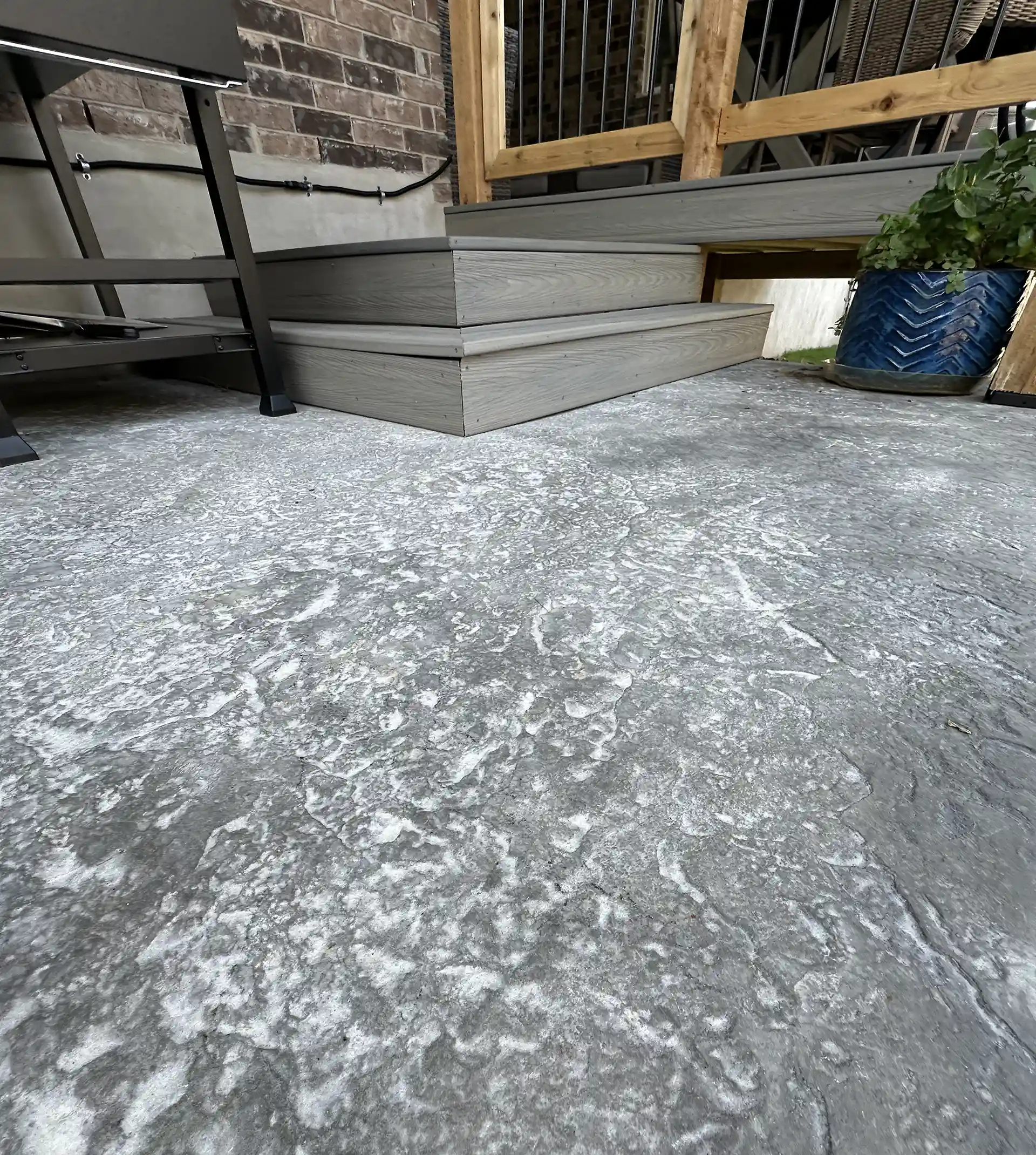The role of stained concrete floors in commercial buildings
Everything About Stained Concrete: A Comprehensive Guide to Its Benefits and Applications
Stained concrete has actually become a popular option for both property and business spaces. Its ability to integrate aesthetic allure with functionality makes it an interesting alternative. Numerous staining techniques supply a series of colors and finishes, enabling customization. However, the advantages expand past appearance. Understanding its applications and upkeep requirements is important for anybody considering this functional product. The nuances of stained concrete invite further exploration.
What Is Stained Concrete?

Staining can be put on numerous surfaces, consisting of floors, driveways, and patios, making it a versatile alternative for both indoor and outdoor areas. The treatment can accomplish a range of appearances, from natural tones to bold, modern-day styles. Unlike paint, stained concrete keeps its appearance with time, as it becomes an essential part of the concrete itself. On the whole, stained concrete works as a reliable approach for transforming ordinary concrete into visually striking surface areas.
Advantages of Stained Concrete
Stained concrete deals significant advantages, particularly in visual charm and toughness - stained concrete. Its vivid colors and special patterns improve the aesthetic beauty of any kind of room, making it a prominent choice for both residential and business applications. Furthermore, the durability of stained concrete assurances that it stays a practical financial investment in time, withstanding damage
Aesthetic Charm
Among one of the most compelling benefits of making use of stained concrete is its remarkable visual allure. Stained concrete offers an one-of-a-kind and flexible appearance that can complement numerous style styles, from contemporary to rustic. The mixture of vivid shades and complex patterns allows homeowners and designers to develop personalized surface areas that can boost the total setting of a room. Unlike conventional floor covering choices, stained concrete can imitate the appearance of all-natural rock or sleek marble, offering an upscale appearance without the connected expenses. Additionally, the shiny surface choices can mirror light, more brightening insides. This flexibility makes stained concrete a preferred selection for both residential and business applications, where visual impact is critical.
Toughness and Long life
The impressive visual qualities of stained concrete are matched by its remarkable durability and long life - stained concrete contractors. Stained concrete surface areas are resistant to deterioration, making them suitable for high-traffic areas both indoors and outdoors. Their durable nature means they can withstand severe climate condition, consisting of extreme temperature levels, rainfall, and UV direct exposure, without significant destruction. Additionally, stained concrete needs very little upkeep compared to other floor covering alternatives, as it does not need constant securing or refinishing. This durability not just reduces replacement prices however additionally adds to a sustainable building approach. In general, stained concrete gives a long-lasting option that combines aesthetic charm with sensible benefits, ensuring its value gradually
Various Sorts Of Staining Methods
Different discoloration strategies can markedly impact the visual top qualities of concrete surface areas. The 3 key methods include acid staining, which responds chemically with the concrete, water-based staining, which offers a more comprehensive variety of shades, and overlay discoloration choices that provide a fresh surface area. Each technique has unique qualities and applications that deal with various design preferences and project demands.
Acid Staining Method
Just how can house owners change ordinary concrete surface areas right into visually striking functions? One efficient technique is acid staining, a prominent strategy that improves the all-natural elegance of concrete. This process includes applying a solution of water, hydrochloric acid, and metal salts to the concrete surface. As the acid reacts with the lime existing in the concrete, it develops rich, variegated shades that appear like marble or rock. Acid staining is understood for its durability and resistance to fading, making it a lasting selection for both indoor and exterior applications. It is vital to keep in mind that the results can vary based on the original concrete shade and texture. Proper application and securing are essential for achieving the desired visual and longevity
Water-Based Discoloration Technique
A preferred option to acid staining, the water-based staining technique offers homeowners a functional method to improve concrete surface areas. This method utilizes water-soluble dyes and pigments, enabling a vast array of colors and finishes. Unlike acid discolorations, water-based stains can be related to unsealed concrete and supply a much easier cleaning process. The outcomes can attain a much more uniform look and can be layered to create distinct effects. In addition, water-based spots are normally less hazardous and discharge less unpredictable natural substances (VOCs), making them much more eco-friendly. Property owners might appreciate the ability to personalize their concrete surfaces with different tones, permitting creative expression while preserving toughness and longevity in their flooring selections.
Overlay Discoloration Options
Various overlay discoloration options exist for house owners seeking to revitalize their concrete surfaces. One preferred option is acid staining, which reacts chemically with the concrete to produce abundant, variegated colors. One more option is water-based staining, providing a wider color palette and much easier application. Furthermore, concrete overlays can be incorporated with patterns for intricate designs, enhancing aesthetic appeals. For a much more textured coating, home owners might think about using stamped overlays that resemble all-natural materials like rock or floor tile. Each useful content method supplies one-of-a-kind advantages, from resilience to customization, permitting for a tailored touch. Inevitably, the selection of overlay discoloration depends upon the preferred look and the condition of the existing concrete, making sure a refreshed and attractive surface.
Applications of Stained Concrete
Stained concrete deals a versatile option for different applications, improving both visual appeal and performance. This material is commonly utilized in domestic, commercial, and commercial setups, making it a popular option amongst engineers and developers. In homes, stained concrete can offer as stylish flooring or exterior patios, offering an innovative look while continuing to be sturdy.
In commercial rooms, such as retail stores and restaurants, stained concrete adds to a modern-day setting and can withstand hefty foot website traffic. In addition, stained concrete is significantly made use of in public rooms like parks and pathways, where its capability to simulate all-natural stone or other products includes visual interest.
Furthermore, stained concrete is perfect for pool decks and driveways, offering a slip-resistant surface that is very easy to keep. In general, the adaptability of stained concrete makes it ideal for many atmospheres, catering to varied tastes and requirements.
Upkeep and Look After Stained Concrete
Appropriate maintenance assures the durability and beauty of stained concrete surface areas. Regular cleansing is important; making use of a moderate detergent and water with a soft-bristle brush aids eliminate dirt and gunk without damaging the surface. It is advisable to stay clear of severe chemicals that can remove the discolor or sealant.
Securing stained concrete is important for defense against wetness, stains, and wear. A top notch sealant should be reapplied each to dig this three years, depending upon the traffic and direct exposure the surface area withstands. In addition, dealing with spills promptly will stop staining and discoloration.

Cost Factors To Consider for Stained Concrete Projects
When preparing a stained concrete task, spending plan considerations play an important duty in figuring out the overall expense. The expenses related to stained concrete can vary significantly based on a number of elements. The dimension of the area to be stained straight affects product and labor costs. Larger spaces will normally require more resources. Second, the type of stain chosen-- acid-based or water-based-- can impact pricing, with acid spots frequently being extra expensive. Furthermore, the intricacy of the design, including patterns or numerous shades, can enhance labor expenses. Preparation work, such as cleansing and grinding the concrete surface, adds to the first expenditures. The choice between Do it yourself installment and working with a professional specialist will certainly better impact the budget. Comprehending these aspects makes it possible for property owners to make enlightened financial decisions about their stained concrete projects, ensuring they accomplish the preferred aesthetic within their monetary methods.
Tips for Picking the Right Stained Concrete for Your Space
Choosing the ideal stained concrete for a details space entails mindful contemplation of various elements beyond just spending plan. Initially, one should assess the desired use the location. High-traffic areas may call for even more resilient finishes, while attractive applications can prioritize appearances.
The shade combination is one more vital aspect; the picked colors ought to balance with existing style and lights. It's likewise essential to take into consideration the surface area structure, as smooth coatings can boost sophistication, while distinctive options might guarantee safety and security in wet areas.
Regional climate and ecological conditions play a significant duty in the durability and upkeep of stained concrete, affecting the choice of sealants and finishes.
Consulting with experts can offer important insights customized to details needs, assuring the choice of the optimal stained concrete that aligns with both functionality and design.
Regularly Asked Inquiries
Can Stained Concrete Be Applied Over Existing Floor Covering?
Stained concrete can undoubtedly be applied over existing flooring, provided the surface area is steady and effectively prepared. This technique enables for an aesthetic upgrade without the need for full elimination of the initial flooring materials.
The Length Of Time Does Stained Concrete Last?
Stained concrete can last for years when correctly maintained. Factors such as website traffic, environmental conditions, and application strategies substantially influence its durability, with many installments staying dynamic and undamaged for 10 to 30 years.
Is Stained Concrete Slippery When Wet?
Stained concrete can be slippery when wet, as the finish may develop a smooth surface. Nonetheless, utilizing non-slip additives or textured finishes can reduce this problem, improving security without jeopardizing the visual charm of the concrete.
Can I Discolor Concrete Myself, or Should I Hire an Expert?
The choice to stain concrete personally or work with a professional rest on ability level and job intricacy. While do it yourself staining can save cash, professionals ensure perfect outcomes, specifically for elaborate styles or large surface areas.
What Colors Are Offered for Stained Concrete?
The range of shades readily available for stained concrete includes earthy tones like browns and tans, find more vivid shades such as reds and blues, and softer shades like pastels. This combination permits for creative, customized style alternatives.